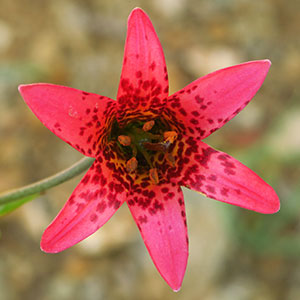Lilium washingtonianum
Lilium bolanderi
Cascade lily, Mount Hood lily, Shasta lily, Washington lily
Bolander's lily
subrhizomatous to ± ovoid, 2.7–10 × 4.4–13.4 cm, 0.2–0.9(–1.4) times taller than long;
scales unsegmented or notched with 2(–3) poorly defined segments, sometimes 2-segmented, longest 3.3–11.9 cm;
stem roots absent.
± ovoid, 3.5–7.9 × 2.6–5.3 cm, 0.9–2.1 times taller than long;
scales unsegmented, longest 3–5.7 cm;
stem roots absent.
to 2 m, often glaucous.
to 1.1 m, glaucous.
rounded in cross section.
rounded in cross section.
in 1–8 whorls or partial whorls, 3–16 leaves per whorl, horizontal and drooping at tips to ascending, occasionally nearly clasping stem, 3.7–12.3 × 0.9–4.7 cm, 2–6.5 times longer than wide;
blade oblanceolate, sometimes obovate, rarely elliptic, margins undulate or not, apex acute, often widely so;
veins and margins ± smooth abaxially.
in 1–5(–6) whorls or partial whorls, 3–19 leaves per whorl, ascending and often cupping stem, 1.8–7.1 × 0.7–2.8 cm, 2.2–4.8 times longer than wide;
blade ± obovate, oblanceolate, or occasionally elliptic, noticeably glaucous, margins nearly always undulate, apex widely acute;
veins and margins ± smooth abaxially.
racemose, 1–33-flowered.
usually umbellate in small plants, in large plants racemose or in 2 whorls, 1–9-flowered.
opening before dusk, ± horizontal, slightly bilaterally symmetric, strongly fragrant;
perianth ± funnelform;
sepals and petals recurved 2/3–3/4 along length from base and scarcely overlapping to form tube, lower usually less recurved than upper and forming landing platform, white, often aging deep pink or lavender, often with short yellowish stripe extending from basal median nectaries, often with fine magenta spots concentrated basally, not distinctly clawed;
sepals sometimes purplish abaxially, not ridged abaxially, (6.1–)6.7–11.3 × 0.9–1.7 cm;
petals noticeably wider than sepals, oblanceolate and often very wide distally, (6.1–)6.6–11.2 × 1.1–2.4 cm, apex widely acute, obtuse, or rounded;
stamens barely exserted;
filaments barely spreading, diverging 2°–8° from axis;
anthers off white or cream, becoming pale pink or yellow, 0.8–1.5 cm;
pollen yellow or cream;
pistil 7.5–10.4 cm;
ovary 1.7–3.4 cm;
style pale green;
pedicel 4.8–15 cm.
nodding to horizontal, not fragrant;
perianth ± campanulate or funnelform;
sepals and petals somewhat recurved 3/5–4/5 along length from base, red or magenta, occasionally salmon pink or pale yellow, with maroon spots, often yellowish on proximal 1/3–1/2, not distinctly clawed;
sepals not ridged abaxially, 3.1–4.7 × 0.7–1.2 cm;
petals 3–4.5 × 0.7–1.1 cm;
stamens included;
filaments barely spreading, diverging 0°–12° from axis;
anthers reddish or magenta, 0.3–0.8 cm;
pollen rust, orange, or yellow;
pistil 2.1–3.5 cm;
ovary 1–2.1 cm;
style green, rarely reddish purple;
pedicel 0.8–14.2 cm.
often with 6 longitudinal ridges, 2.7–5.8 × 1.6–2.9 cm, 1.3–2.3 times longer than wide.
2–4.1 × 1.2–2.1 cm, 1.4–3 times longer than wide.
123–231.
90–210.
= 24.
Lilium washingtonianum
Lilium bolanderi
Subspecies 2 (2 in the flora).
(Discussion copyrighted by Flora of North America; reprinted with permission.)
I. M. Johnston (1923) noted that Lilium bolanderi Watson was based on a mixed collection including L. kelloggii, and he argued that Watson intended the name to apply primarily to the latter species. Thus he proposed the name L. howellii for this diminutive, red-flowered, serpentine endemic. A. D. Cotton (1936) correctly concluded that Watson’s description applied primarily to the specimens here called L. bolanderi, and this view is now widely accepted.
Lilium bolanderi hybridizes with L. rubescens, L. washingtonianum subsp. purpurascens, and subspecies of L. pardalinum.
Bolander’s lily is primarily pollinated by Allen’s and rufous hummingbirds (Selasphorus spp., family Trochilidae).
(Discussion copyrighted by Flora of North America; reprinted with permission.)
1. Sepals and petals aging light pink or remaining white; bulbs sometimes (36%) without notched or segmented scales; sepals 8–11.3 cm; Sierra Nevada and s Cascades of California. | subsp. washingtonianum |
1. Sepals and petals aging deep pink or lavender; bulbs usually (88%) with some notched or segmented scales; sepals (6.1–)6.7–9.5 cm; mountains of n California and Oregon. | subsp. purpurascens |


